|
New York Zoological SocietyTHE GALAPAGOS TORTOISESIN THEIR RELATION TO THE WHALING INDUSTRYBY CHARLES HASKINS TOWNSENDDirector New York AquariumNEW
|
Contents
|
Illustrations.
|
|
Zoologica Vol. IV, No. 3, 1925
THE GALAPAGOS TORTOISESIN THEIR RELATION TO THE WHALING INDUSTRY
|
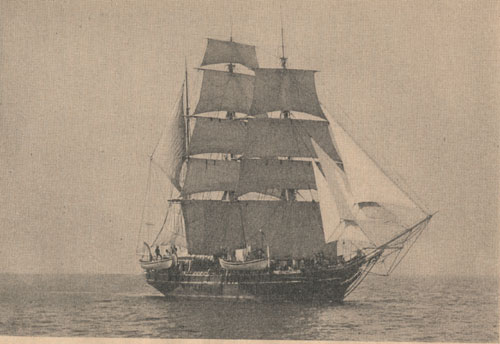
56
|
the passing merchantmen, carried away as many tortoises as they had space for, the whalemen made heavier demands upon the supply than any of the others. No other class of sailormen was ever so numerous in eastern Pacific waters. While in service at the Court of Arbitration at The Hague in 1902, the late Captain George Baker of New Bedford, a veteran whaleman, was associated with the writer, and learning that he had visited the Galapagos imparted much information relative to tortoise hunting by whalemen among those islands. With these interviews in mind, it seemed probable that the logbooks of whaling vessels, if available, would yield new information on these nearly extinct animals, and a search was accordingly made for them, which was crowned with a fair measure of success. We have now at hand records from the logbooks of seventy-nine whaling vessels2 that made one hundred and eighty-nine visits to the Galapagos between 1831 and 1868 for the purpose of securing tortoises. Their combined catch during this period was 13,013. The study of a larger collection of logs would undoubtedly yield more information of statistical value, but the records already available afford a safe measure by which to gauge the effect produced by the fleet as a whole. In view of the facts that there were more than seven hundred vessels in the American whaling fleet at one time, and that the majority of these made repeated voyages to the Pacific during the above mentioned period called the golden age of whaling, it is evident that the catch here recorded was a mere fraction of the numbers of tortoises actually carried away. It is also evident and much to be regretted, that hundreds of old whaleship logbooks have failed to make a home port in some historical library with other sea-wanderers of their kind. The attics of old whalemen's homes doubtless contain many of them, which it is hoped, may eventually be brought together. We have as yet examined only those preserved in the libraries of New Bedford, Nantucket and Salem. These are of course the logs of American vessels only. What tortoise history lies concealed in those of vessels belonging to Great Britain and other Countries formerly engaged in whaling in eastern Pacific waters can only be conjectured. British whalers disappeared from this region during the war of 1812 and the American fleet was greatly reduced. Many vessels 2 See lists of vessels, pp. 77-82 and Appendix, pp. 103-135. |
were captured on both sides. None of the logbooks at hand is of earlier date than 1831, although vessels of both countries were whaling about the Galapagos during preceding decades. The extracts from the logs supply data respecting tortoises that have hitherto been lacking, giving not only the dates and the separate islands visited but in most cases the numbers of tortoises secured at each. As each island of this anomalous archipelago bore its own particular species of tortoise,3 the most of which are now extinct, the logbooks of the whalers furnish considerable information respecting the progress of the work of extermination. They contain also information as to the methods practised in collecting and transporting tortoises. The numbers of tortoises taken by some vessels cannot always be given in full. There are occasional log entries giving the catch by "boat loads," and these being difficult to estimate, are ignored in our summing up. In the list of vessels with catches recorded definitely, there are eight with log entries mentioning additional "boat loads." The ship Phoenix at James Island on July 20, 1835, makes record of twelve tortoises brought on board, and from the 25th to 28th, seven "boat loads" more. This being in 1835 when tortoises were abundant enough to permit selection of such convenient sizes for carrying as fifty to seventy-five pounds, a "boat load" might have consisted of twenty or more tortoises of such sizes. Allowing this particular vessel merely the average known catch per vessel during that decade, her supply of tortoises from James Island was not less than eighty-six. Doubtless the number was much larger. The whale-boat, twenty to thirty feet in length, has a large carrying capacity. According to the log of the bark Morning Star at Chatham Island on July 10, 1861, "all three boats came on board each one brought 20 Turpin." Captain Barnard's narrative of the ship Millwood says "Mr. Coles had forty-five terrapin in the boat," which indicates a still greater carrying capacity. The number of tortoises actually taken by the vessels on our list was therefore considerably greater than the total given above. The logbooks of some vessels record the presence of other whaleships among the islands, seeking tortoises, many of them with 3 Naturalists are not in accord as to the validity of some of these so-called species. A few of the islands have been inhabited at times since 1832 and all have been visited by vessels to such an extent that more or less transportion of tortoises among the islands could not have failed to take place. Specific names have been bestowed upon immature specimens which are different in appearance from very old ones, while the localities from which some museum specimens were derived are uncertain. |
names not found in the present list. Were the scrawled and stained records of all available, there would be many more tales of arduous hunting of tortoises in the sun-baked, cactus- and thorn-filled gullies of the islands. The log of the ship Hector of New Bedford, at Albemarle on November 2, 1841, has this entry: "boats returned with 10 Terrapin, Rodman [another whaleship] about the same, . . at daylight 7 ships in sight." The log of the ship Barclay contains this entry under date of August 11, 1835: "Narborough bore S.E. distant 25 miles, saw 9 ships cruising." In the log of the bark Henry N. Crapo, at Barrington Island on April 12, 1853, we find the names of six other whaleships that were in sight at the time. The log of the ship Congaree, at Chatham Island on July 6, 1847, has the following record: "3 boats started for Terrapin, saw 3 ships at anchor at Terrapin Road." Since the seventy-nine vessels whose logs constitute the basis of this study, averaged more than two visits each to the Galapagos for the purpose of securing tortoises, we may assume that it was the practise of all vessels cruising for sperm whales in the eastern Pacific to do so. It was in fact a rendezvous for the fleet. In 1852 three whaleships were lost among these islands. "Turpining" as the whalemen called it, was therefore the attraction that accounted for their presence at the Galapagos. Some of them got wood for fuel and a very few found fresh water, but all sought tortoises. They relied on them for fresh food and made special preparations for collecting them. In the log of the bark Atkins Adams at Chatham Island on July 5, 1861, there is a record which reads, "Employed in geting straps ready to fetch tearpin with." Another log says "All hands employed in making belts to go after terpen." Tortoise hunters were sent ashore by the boat load. The log of the Edward Carey at Albemarle on November 9, 1862, in company with three other vessels, contains this record: "Each ship have sent one boat with nine men apeace after terrapin." Tortoises weighing from fifty to seventy-five pounds were the sizes most readily transported. A tortoise to a man was the usual load, the carrying of which was called "backing them down." Sometimes men were sent ashore with provisions for several days' work. The log of the ship Pocahontas at Chatham Island on August 30, 1861, says "sent two boats ashore with provisions and water for 3 days." |
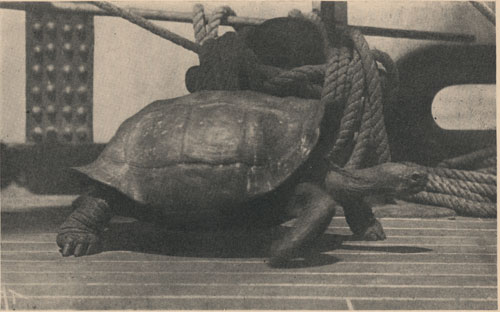
60
|
Tortoises too large to be moved were frequently killed and the meat carried on board for immediate use, while others were turned on their backs and dragged by means of ropes tied to their legs. The latter method of transportation was, however, practicable only on favorable ground and for short distances. Large tortoises were also slung to oars to be carried by two or more men when the distance was not great. It was unquestionably hard going for the tortoise hunters over the broken volcanic waves that are called land in the Galapagos, even for able-bodied seamen accustomed to long tugging at the oars of whaleboats: One tortoise hunter says "we got about 250 altogether which cost us much trouble." Another writes in his log: "at 8 P.M. on board tired oute," and another, "returned with five Terrapin and intirely exhoisted." The writer, who has tried tortoise hunting, finds it easy to sympathize with them. Ships visited the islands at all seasons of the year. A successful catch at one season on an island where tortoises were plentiful could not always be duplicated a few months later the tortoises having moved into higher country in search of water. In the larger islands water is usually to be found in the elevated interior regions when totally lacking at lower coastal levels but the tortoises apparently occupied lower country as long as water was there available. It was to the lower country, chiefly, that female tortoises resorted to dig holes for their eggs; a habit contributing greatly to their decimation, as this region was most exposed to the raids of the hunters. The medium sized animals were the ones most sought for convenient transportation and these happened to be the females. Darwin says: "the old males are the largest, the females rarely growing to so great a size." Porter writes that of the "fourteen tons" of tortoises taken aboard his ship at one time in 1812 "only three were males." These records throw light on the fact that the tortoises obtained by scientific expeditions later on, were largely males. Travel is exceedingly difficult in all islands of the group and whalers seldom attempted to penetrate far inland. Otherwise the supply of tortoises could hardly have lasted as it did throughout the long period of whaling activity. It was no uncommon experience for seamen to get lost and remain ashore over night, while in some |
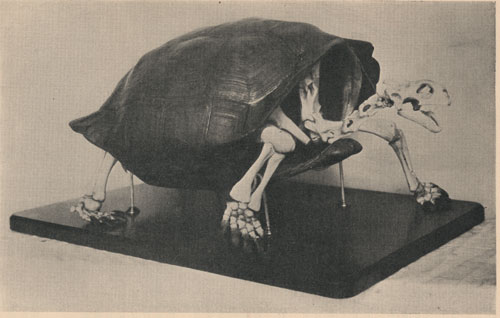
62
|
instances lost men were finally abandoned to their fate. The following melancholy record is from the log of the ship Chili at Albemarle Island in 1841: "Sept. 25, 6 P.M. two boats came with 22 [tortoises] lost a man, . . . daylight Sept. 26 sent all hands to look for lost man." "Sept. 27, could not find him, left bread and water and directions in a bottle if anyone should ever find him. Occasionally a lost Crusoe, if he had succeeded in finding water, was picked up by another vessel after weeks of solitude. According to the records at hand, tortoises were taken from nine of the islands of this. group: Chatham, Albemarle, Charles, Hood, James, Abingdon, Duncan, Indefatigable and Barrington. Fifteen4 species of tortoises have been described from these and the small island of Jervis, five being from the large island of Albemarle. The smaller and lower islands were the first to be stripped of their stocks of tortoises but scattered numbers existed on some of them for many years after the whalers vanished. Albemarle, the largest of the islands, has a length of seventy-two miles, an average width in its northern part of ten miles and in its southern part of twenty miles. Its greater elevations have heights varying from 3700 to 5000 feet. Indefatigable, the next in size and rather rounded in outline, has a diameter of about twenty miles. Its central elevation is 2296 feet. Narborough, third in size and also somewhat rounded in outline, has a diameter of about fifteen miles. Its volcano is 4300 feet high. Chatham measures nearly twenty-four miles in length by eight in width. Its greatest height is 2500 feet. James is also one of the larger islands having a length of twenty miles and an average width of ten miles. Its elevations are from 1000 to 2700 feet. All of the remaining islands which bore tortoises are of much smaller size than the preceding, but most of them have elevations exceeding 1000 feet. All islands of the group are on or near the Equator. From Charles Island which was inhabited by a large colony of Ecquadorians during the "thirties," the tortoises practically disappeared during that decade. Darwin who visited Charles Island in the Beagle in 1835 stated that the main article of animal food of the settlers was derived from the tortoise. According to the logbook records now before us, the ship Aurora "got a few Turrapin" from Charles Island in 1848, but these must have been purchased as the inhabitants were already drawing supplies of tortoises from other islands. 4 The late Doctor Van Denburg's List of species. |
The last record for James Island is that of the bark Alfred Tyler, in 1845, which took twelve tortoises on October 11. The ship Good Return of New Bedford with four boats' crews ashore in 1848, "could not find any." The very small island of Barrington saw almost the last of its tortoises in 1839, when the ship George and Susan of New Bedford took twenty-two on December 21 and 22. The bark Henry N. Crapo of South Dartmouth, visited Barrington on April 22, 1853 but found only one tortoise. Hood Island, which is somewhat smaller than Charles Island, yielded 1698 tortoises to the vessels in our list, the last, seven in number, being taken on September 26, 1853 by the ship Congaree of New Bedford. There are logbook records for Chatham, a large island, as late as 1863, for Abingdon in 1867, and for Duncan in 1863. During the fifties and sixties five vessels obtained a total of only sixteen tortoises on Abingdon while Duncan one of the smallest, yielded 356 during the same period. It is a singular fact that tortoises survived in small numbers on Duncan Island long after they had practically disappeared from Charles, James, Hood, Chatham and Abingdon, all much larger islands. One specimen only was-found there by the Williams Expedition in 1923, none having been seen elsewhere. Chatham Island was seldom visited by whaleships until 1837 when the ship Omega took two hundred and forty tortoises in nine days. In 1861 five vessels secured there an average of only eighty-seven tortoises in nine days' average work. During the period covered by our records, 1831 to 1868, this island yielded nearly twice as many tortoises as Albemarle, next in point of catch by whalers. Chatham was not colonized until 1855, a condition favorable to its tortoise life as compared with Charles Island, colonized in 1832. For Indefatigable, one of the large islands (named after a British frigate in 1816) the catch by whaling vessels is surprisingly small, although Beck reported them as "not rare" in 1906. The total taken there by whalers from 1833 to 1848 – the last, was three hundred and sixty-six. Albemarle, largest of the islands, rugged and mountainous, continued to yield tortoises to energetic hunters long after they had become scarce elsewhere. While the Galapagos Islands undoubtedly furnished large sup- |
plies of tortoises to passing vessels during the greater part of three centuries, the estimates of the numbers carried away seem, in view of the figures contained in our logbook records, to need revision. Doctor Bauer who visited the Galapagos in 1891 thought that ten millions of tortoises might have been taken from the islands since their discovery. Reynolds estimated the tortoise catch of thirty-one whaling vessels at Charles Island in 1832 and 1833 at 200 each. This average may be too high. Our records for the thirties show that the average catch at Charles Island by nine vessels during that decade was 138. The average per vessel for the Galapagos dwindled to sixty-two for the three following decades. There is no evidence that tortoises were ever found on Culpepper, Wenman, Bindloe or Tower Islands and the logs of the whalers contain no references to them. The first two are little more than rocks. The ship Good Return of New Bedford anchored at Tower Island – possibly in the large bay – on December 27, 1848 and "lowered all four boats – went ashore after terrapin – could not find any." The ship Gay Head of New Bedford sent boats ashore at Tower Island on February 17, 1853, which according to the log, returned with "not very flattering accounts as regards Terrapin." Their absence from a low island such as Tower is doubtless due to lack of water. This island two miles in length, has an elevation of only 211 feet, while Duncan, still smaller has an elevation of 1300 feet. Other small islands that bore tortoises were all much higher than Tower, Abingdon having an elevation of 1950 feet, Barrington of 900 feet and Jervis, smaller than any of these, a height of 1050 feet. All of the tortoise-bearing islands are known to have water in their higher sections during all or part of the year. The ship Zenas Coffin of Nantucket visited Jervis, the smallest of the tortoise-bearing islands, on July 12, 1850, and "sent in two boats to find terrapins but did not see any." This is the only reference to Jervis Island found in the whole series of logbooks. There are single specimens of the Jervis Island Tortoise (Testudo wallacei) in the Rothschild museum and the California Academy of Sciences, apparently the only specimens in existence of this extinct species. The tortoises taken on Crossman and Cowley, small islets close to Albemarle, are included in the catch made on that island. Narborough, third in size among the islands, is not mentioned in the logbooks in connection with tortoise hunting, although there |
The best catches made during the 'sixties by a similar number of vessels, averaged less than half of those made during the 'thirties varying from sixty-three to one hundred eighty-eight, while the time in securing tortoises was from five to fifteen days:
These vessels took only 693 tortoises in an average hunting time of nine days. There were other agencies besides food-seeking ships at work affecting the tortoises. The settlements of Ecuadorians on Charles Island and later on Chatham and Albemarle islands, used them not only for food but for their oil, which was sold to whalers for culinary purposes or sent to markets on the mainland. Large numbers of tortoises were regularly killed for their fat alone. In the settlements tortoises were kept for sale to whalers and there were a few small Ecuadorian vessels that gathered them for the same purpose. The log of the ship Robert Edwards at Chatham Island on December 24, 1843 contains the following: "At 9 P.M. the boats all came off and brought the remainder of their Terrapin makeing 190 in all and 72 that the Captain bought." The log of the ship Edward Carey, at Indefatigable Island on December 28, 1863, has this entry: "At 10 A.M. a small schooner Anchored close to us the Captain went on board bought of them 78 Terripan." The log of the ship George and Susan, off Charles Island on August 30, 1855, contains this record: "Spoke a brig from the coast that wanted to sell Terrapin." The domestic animals – dogs, cats and-pigs, becoming wild and increasing in numbers, proved destructive to the eggs and newly hatched young of the tortoises. At the present time, wild dogs 6 Not including those purchased from a small trading schooner. |
probably constitute the greatest danger to which the small remnant of tortoises in the mountains of Albemarle is exposed. Beck in 1906 found the native oil makers still at work in the high interior of Albemarle and dogs were both numerous and destructive. In the various searches that have been made for tortoises during the past thirty years by scientific expeditions, islands have been stripped of all that could readily be found and the belief expressed that few remained, yet later expeditions managed to pick up stragglers. The explanation is probably that where dogs are not found, the very young are easily overlooked, but after a few years became large enough to be detected. These volcanic islands are so rough and brushy, so gashed with deep cactus-filled gullies, that the small tortoises that have escaped rats, cats, dogs and pigs in infancy often find lodgement in places that can be explored only with painstaking effort. It is possible that surviving tortoises may again be found on Duncan, Hood, James and Abingdon islands. There are a few records respecting the length of time tortoises lived on board the whaleships. An entry in the log of the bark Equator of New Bedford, on September 8, 1846, reads: "killed our last Terpen which has lived on air for four months and made a good mess for all hands." This evidently was the last of the one hundred fifty tortoises taken by the Equator from Albemarle Island on April 22d of the same year – four and one-half months before.7 Morrell says "I have had these animals on board my own vessels from five to six months without their once taking food or water. . . . They have been known to live on board of some of our whaleships for fourteen months." Porter says "No description of stock is so convenient for ships to take to sea as the tortoises of these islands. They require no provisions or water for a year. . . . They have been piled away among the casks in the hold of a ship, where they have been kept eighteen months." It is known however that tortoises lived indefinitely on board vessels and that whaleships frequently kept one or two throughout the voyage of two years or more, as pets, finally landing them alive at the home port. The following information on this point, was contributed in September, 1924, by Mr. George A. Grant of Nantucket, who spent the greater part of his life as a whaler, and who visited the Galapagos: "Shortly after the ship Niger of New Bedford 7 See extracts from log of Equator, Appendix, p. 118. |
left the Galapagos, one tortoise disappeared. Two years later when the ship arrived at New Bedford, the tortoise was found alive among the casks in the lower hold." Several citizens of New Bedford and Nantucket have spoken recently of tortoises that were brought home years ago by whalers. Mr. Frank Wood, curator of the Whaling Museum at New Bedford, related his experience with two tortoises brought home in the early 'sixties by a whaleship owned by his uncle Mr. Edward W. Howland. who kept them in his garden. Mr. Wood spoke of riding on them, saying that a tortoise had first to be started, after which he got on its back. According to Mrs. Johnson Whiting of West Tisbury, Massachusetts, Captain James Cleaveland, of the ship Seaconnet of New Bedford, brought home two tortoises in 1873. They were kept in his yard .where they ate grass and were very contented until cold weather came when for lack of suitable winter quarters they were killed and eaten. In "Four Years Aboard the Whaleships," by William B. Whitecar, Jr., on page 97, the author tells of a Madagascar terrapin that was kept in the hold of a whaler for fifteen months and at the end of that time was "still quite fat and good eating." The name tortoise was seldom used by the whalers. They knew the animals as terrapin, which they usually spelled "turpin" but there were many variations; captains, mates and occasional seamen keeping private. logs, wrote it "turpin," "turpine," "tarpain," "turupin," or "terapen," the spelling depending as Sam Weller says "on the taste of the speller." When at anchor, the shipkeeper sometimes wrote in the log, "the boats ashore turpining" or "all hands a-turpining." In the log of the ship Loper only, are they referred to as tortoises. There is nothing in the logbooks of the whalers respecting the habits of tortoises, but this subject is well presented in an interesting and important article by R. H. Beck, which was published in the "Report" of the New York Zoological Society for the year 1902. The sizes attained by tortoises of the Galapagos were probably as great as those recorded of tortoises taken from islands of the Indian Ocean, one of which, now in the BFitish Museum, had a weight of eight hundred and seventy pounds. They may have been even greater, but the weights of the monsters described by whalers |
in the following pages were estimates only. In the matter of length we are better informed. There are specimens in European museums in which the straight length of carapace exceeds four feet and in American museums, three and a half feet, Porter describes the taking of tortoises on Indefatigable Island in 1812 "of an enormous size, one of which measured five feet and a half long." The Galapagos tortoise described by Messrs. Daggett and Heller, lived sixteen years in California, having attained a length of forty-one inches and a weight of four hundred and fifty pounds. It was a young tortoise when captured. The weight of Porter's five and a half foot tortoise may have approached those celebrated among the whalers as giants of marvellous size. While American whaleships, numbering more than seven hundred at one time, did not all go to the Galapagos, or even to the Pacific, those that did so undoubtedly made repeated visits, as the logs at hand indicate. It would be within safe limits to credit American whalers with taking not less than 100,000 tortoises subsequent to 1830. The whaleships of other countries also visited the Galapagos, although not to the same extent. There are no records available respecting the possible numbers of tortoises removed from the islands by passing merchant vessels during the whaling period and preceding it. This source of destruction continued as long as tortoises were available either by hunting or by purchase from the settlers. No one has attempted to summarize the captures made by the early navigators that have left records, and little is known of what the buccaneers and the sealers that followed them did to the tortoises. A couple of centuries of tortoise hunting prior to the advent of the whalers must have resulted in the taking of great numbers. It doubtless would be possible to recover some of the logbooks of the sealing fleet. The men-of-war also are to be considered, since like the buccaneers, they had larger crews to feed than the whalers. Porter confesses to loading "about fourteen tons" of tortoises from James Island on one of his ships in 1812. He also mentions taking on board "between four and five hundred" at Charles Island. The greater part of the destruction subsequent to the establishment of the first settlement in 1832, may well be attributed to the hundreds of Ecuadorian inhabitants on Charles, Chatham and Albemarle islands who found in the tortoises not only their main |
subsistence for many years but the basis of the oil making industry that, according to Beck, was still in progress in 1906. Doctor Bauer's supposition that ten millions of tortoises were carried away by ships may be incredible, but there is little doubt that such figures would be required to account for the enormous numbers that have disappeared in various ways since the discovery of the Galapagos. While the object of the writer in the present paper is to report upon the hitherto overlooked records of the whaling fleet, he can not entirely ignore the problem of the origin of the tortoises for which the Galapagos Islands are chiefly celebrated. The long-isolated and very peculiar animal and plant life of the islands is remotely of American origin. In attempting to account for its presence some naturalists are disposed to accept a theory which presupposes a former land connection between these volcanic islands and the mainland. This would require as Milton says, "a bridge of wond'rous length." The coast of Ecuador lies five hundred miles from the most easterly of the islands, with ocean depths between as deep as two and a half miles. In the direction of Central America the distance is six hundred miles, with intervening depths exceeding two miles. Participation in the actual work of sounding these depths has naturally served to render their measurements impressive to the writer. If a former land bridge from the American tropics, with their surpassingly rich fauna and flora, is necessary to account for the very limited number of animal and plant forms inhabiting the Galapagos, it is pertinent to inquire, why was it so little used? Mammals are represented only by a few bats, of land birds there are only about sixty species, of reptiles only twenty-six, and of insects and of plants only a few hundreds. The transportation of some of these can be accounted for readily in other ways: The numerous islands, one of them seventy-two miles long in a north and south direction, extend through one hundred thirty miles of latitude and one hundred forty of longitude. Lying directly across the paths of the prevailing westerly currents and winds the position of the Galapagos Archipelago is such as to favor the accumulation of drifting objects. Tith such conditions enduring through a long period of time, it is inconceivable that various forms of living flotsam could have failed to arrive there. |
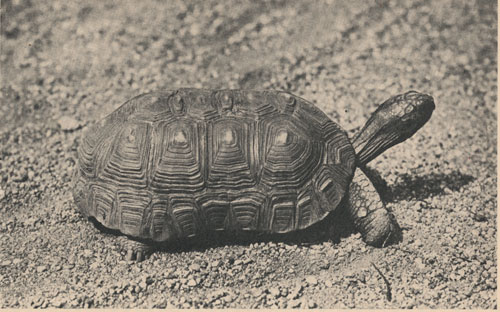
72
|
The hardy tortoise, able to live for months without food or water, and like all four-legged animals, able to float and even swim for a time, would have as good a chance to survive the voyage as the lizards or any of the early involuntary Galapagan immigrants that lacked the power of flight. The ancestry of the island tortoises need not be regarded as mysterious, with so close a relative as Testudo tabulata living no farther away than the Isthmus of Panama. Within the past year, our associate, C. M. Breder of the Aquarium staff, has found this large and widely distributed species living in considerable numbers on the Isthmus, where it is a common pet with children of the native villages. He also brought living specimens to the Aquarium. Individuals are recorded of more than twoo feet in length of shell. What size and coloration it might acquire, if removed from the rainy forests of the Isthmus, where it is subject to human molestation, and placed in the dry volcanic environment of the Galapagos, affords food for thought. The longer we contemplate this Panama tortoise, with characteristics differing but little more from the average Galapagan animal than do the various island forms of the latter from each other, the more are we disposed to agree with Garman that "the origin of the Galapagos tortoises is directly connected with the species Testudo tabulata of northern South America." It is within the range of possibility that the introduction of tortoises was brought about through human agency. While there is no evidence that these islands were known to primitive man, there is also no evidence that he was not there temporarily. With a vast, populated' mainland lying a few hundreds of miles to windward and from which currents set continually toward the islands, it is conceivable that canoes or floating trees with castaway tortoises might have drifted there. All explorers of the rivers of tropical America are familial' with the food gathering canoe of the aborigine. Whatever agency was responsible for the tortoises, and that will doubtless remain unknown, they found abundant food and no enemies at the Galapagos. Their amazing development both in size and numbers was a matter of isolation under conditions exceptionally favorable to them. The only other instance of existing species of tortoises attaining equal development, was under similar conditions on islands inn the Indian Ocean. |
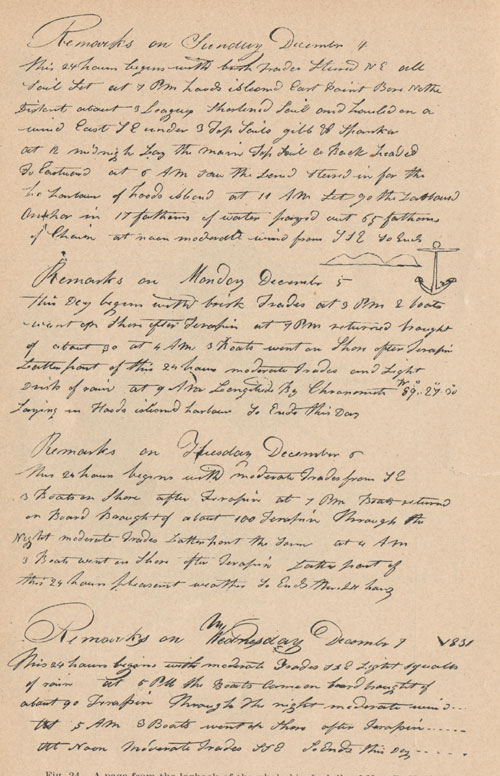
74
|
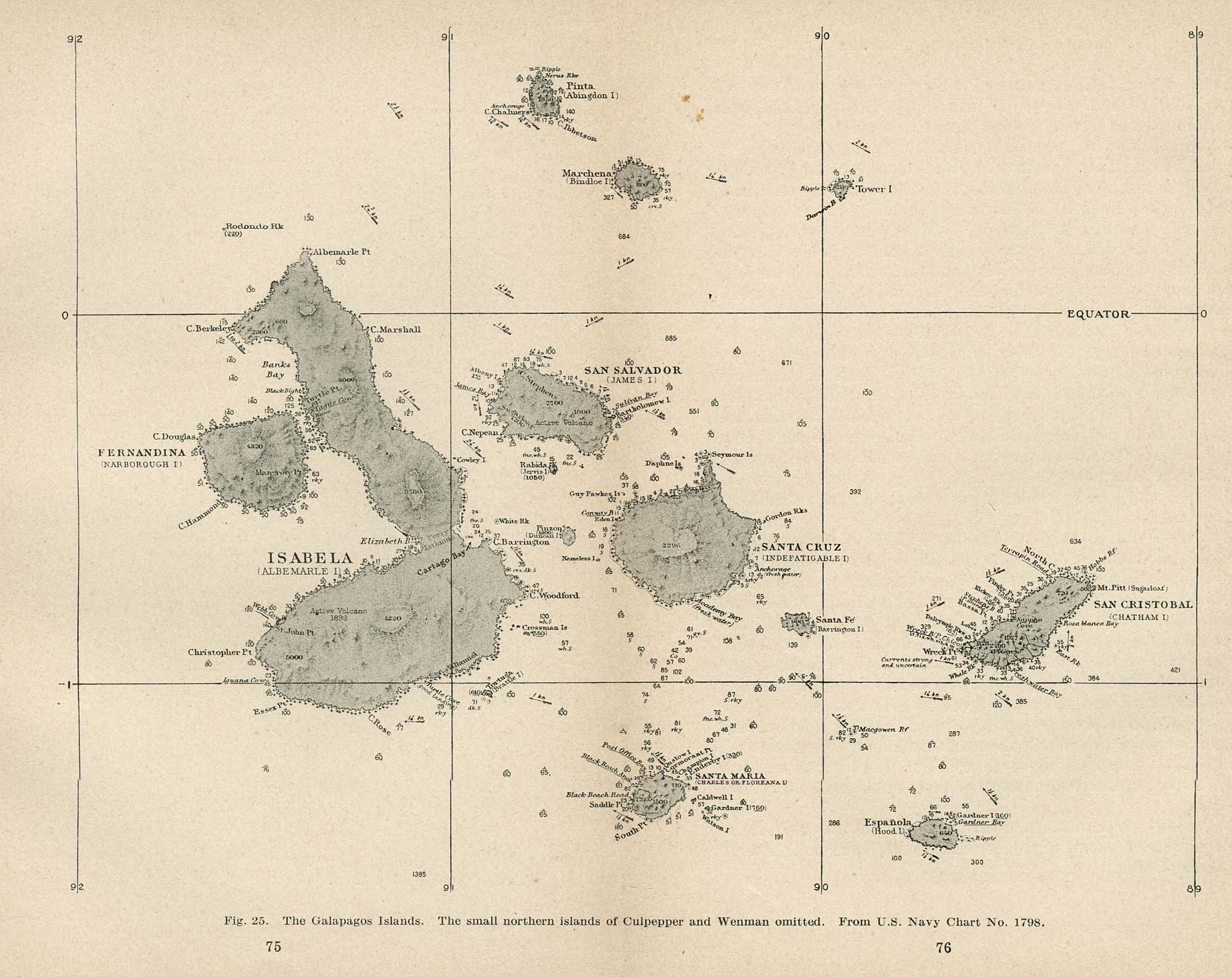
The Galapagos Islands. The small northern islands of Culpepper and Wenman omitted. From U.S. Navy Chart No. 1798.
|
|
Fig. 25. The Galapagos Islands. The small northern islands of Culpepper and Wenman omitted. From U.S. Navy Chart No. 1798. |
In the following list of vessels there is shown a catch of 10,373 tortoises. The number of vessels participating is given as one -hundred and fifty-one, but it should be understood that this number means visits when tortoises were secured; many vessels having called at the islands two or more times. The ship George and Susan obtained tortoises seven times between 1835 and 1856; the ship Hector seven times between 1832 and 1843, and the ship Congaree eight times between 1847 and 1853. Large catches were often made. Four vessels took over three hundred each, eight other vessels over two hundred each, thirty-three over one hundred each, and twentyfour over fifty each. The largest recorded catches of tortoises from a single island are 350, 335, 315 and 310: TORTOISES TAKEN FROM THE GALAPAGOS ISLANDS BY CERTAIN WHALESHIPS FROM 1831 TO 1868 8
Catch shown by Islands
8 For extracts from the logbooks of these vessels see appendix, where they are arranged chronologically as in this list. 9 First voyage made in 1795. |
10 The oldest whaler built in 1801 for Stephen Girard of Philadelphia. Broken up at New Bedford in 1893. |
|
Total visits by above-named 67 vessels – 151 11 Built 1843, last voyage 1914, see frontispiece. |
Above Catch of Tortoises Arranged by Decades
Showing number of visits by vessels and average taken at each visit
Same Catch Arranged by Islands
In the following list of twenty-nine vessels making thirty-eight visits to the islands the numbers of tortoises taken are not recorded. Allowing these vessels the same average catch for each decade, as the sixty-seven vessels making one hundred and fifty-one visits, with definite records, their catch may be estimated conservatively as follows:
Estimated Catch of Tortoises
Based on the Recorded Catch – Arranged by Decades
The recorded catch of 10,373 tortoises by vessels making one hundred and fifty-one visits, and the estimated catch of 2640 by vessels making thirty-eight visits, gives a total of 13,013 tortoises taken during one hundred and eighty-nine visits. | |||||||||||||||||||||||||||||||||||||||||||||||||||||||||||||||||||||||||||||||||||||||||||||
List of Vessels Seeking or Obtaining Tortoises at Various Islands from 1833 to 1867, but Numbers Taken not Recorded
|
Estimated Catch Arranged by Islands. Based on Recorded Catch
The following table of the total catch shows that whaleships obtained a larger number of tortoises during the 'thirties than in any subsequent decade. The catch from 1840 to 1849 was smaller, although more vessels visited the islands. The catch and the number of vessels both decreased during the two succeeding decades:
Total Catch of Tortoises Arranged by Decades
Arranging the total catch of tortoises by islands, we find Chatham Island, with 4,798, far in the lead in point of numbers taken. Albemarle is next, with 2,493; the position of other islands in respect of catch being in the following order: Charles, Hood, James, Abingdon, Indefatigable, Duncan, Barrington. The yield from the last four is small as compared with the others:
Total Catch of Tortoises Arranged by Islands
12 Reported in log of ship Edward Carey, February 13, 1861. |
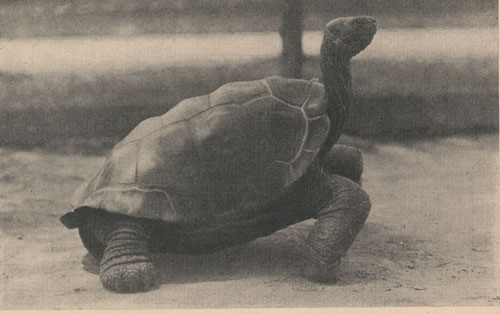
84
|
Subsequent to the period under consideration – 1831 to 1868, the visits of whaleships had but little effect on the tortoises of the Galapagos Islands. The discovery of petroleum in 1859 affecting the price of whale oil, and the Civil War immediately after, with its heavy losses of vessels, marked the beginning of a decline from which the industry never recovered.
Unpublished Notes on Galapagos Tortoises
Contributed in 1924
Most of the later writers on the tortoises of the Galapagos have quoted extensively from the works of the navigators who saw them in the days of their greatest abundance. We need not here repeat these much-quoted accounts, but there are some works relative to the whaling industry that have not, so far as we know, been ~ quoted in connection with the hunting of tortoises, which contain interesting information on this subject. It is possible to add also some unpublished accounts of tortoise hunting received from veteran whalemen and others while engaged in our search for logbooks of whaling vessels in 1924. Mrs. Johnson Whiting of West Tisbury, Martha's Vineyard, contributes the following account of tortoise hunting, given her in August, 1924, by her neighbor, Mr. Russell Hancock, a vigorous man of eighty-two: "I went to the Galapagos Islands for terrapin. It was in 1865, on my first voyage to sea on the bark Samuel and Thomas of New Bedford, of which my brother-in-law, Captain Wm. Lewis, then of West Tisbury, was master. We landed on Albemarle, uninhabited, of a volcanic mountainous construction, full of crevasses which made it hard and almost dangerous walking. We went ashore at daylight and walked until noon climbing up the mountain and crossing sort of bridges across the crevasses that former parties had made; then we left half our drinking water and went on capturing the terrapin which were feeding on the very sparse -tufts of grass. We had hard work finding turtles small enough for two men to carry. When we did we rolled them over on their backs until we had enough, about 50 I think. Many huge turtles had carved on their backs the name of some whaling ship and a date of years before. I have often heard tell that a vessel went over from Panama with two donkeys and procured terrapin so large that two of them weighed 2,200 lbs. We had brought long iron |
poles with us and we lashed the terrapins' legs together, slung them on the poles and so carried them back to the ship,-one man on each end of the pole. We valued them very much for fresh meat. I don't think anything ever tasted much better than fried terrapin liver. One thing we used to feed the turtles on board ship was bananas." Mr. Lafayette Gifford of Westport Point, Massachusetts, makes the statement that his father, who was a whaling captain, "visited the Galapagos in the 'fifties and saw there a renowned tortoise that was supposed to weigh over a thousand pounds. This tortoise had names carved all over its back. A British war ship finally took it away with the aid of tackles and a derrick. It was then but little longer than it was 150 years previously." Perhaps the original dimensions were carved on its back. Mr. George A. Grant of Nantucket made a visit to the Galapagos in 1881 on the bark Alaska of New Bedford. At Perry Isthmus on Albemarle Island he saw a tortoise of extraordinary size that was famous among the whalemen and was known as "Port Royal Tom." There were dates and names carved on his back, the oldest date being 1791. Mr. Grant said that tortoises too heavy to lift were turned on their backs and dragged by means of ropes tied to their legs. An unpublished note on the Galapagos tortoises, written by Weston Howland, who visited the islands in a whaleship, "probably in 1830," is contribtued by his daughter, Miss Rachel Howland, of Fairhaven, Massachusetts: "We proceeded to James Island, which is about sixty miles in circumference-and there anchored in a safe bay and sent a boat ashore. We found no inhabitants, but a pond of brackish water. Birds were plenty and so tame that a number of them were caught by hand, mostly teal, and the awkward flamingo with its beautiful plumage. In the morning a boat was fitted for an excursion in a bay or cove several miles away, for a load of terrapin. Arriving at the cove, a party consisting of sixteen officers and men, leaving we (two) boys to have a care of the boat, left for a cruise up the sharp volcanic side of the hills, to the feeding grounds of the hard shelled and long necked fellows. The principal food of the Gallipagos terrapin is the cactus tree and grasses which are found on the high lands and which get their moisture from the near neighborhood of the clouds, as it seldom rains on the west |
coast of South America so near the equator. The terrapin can and does, live six or more months without water, as he is provided with a vessel or bladder, in which he lays in a stock which he carries with him. This water is at any time as clear as amber and seems entirely pure and clean. The officers and men having returned from their mountain expedition, each with a large terrapin secured on his back, that would weigh seventy-five pounds or more, lunch and a good drink of water was served. They then returned to the feeding ground for another load, which they came back with in time to load the boat and return to the ship before dark, with a supply of delicious food for a month or more." The catch in this case appears to have been thirty-six tortoises, which, at seventy-five pounds each, weighed 2,700 pounds. Mr. Paul W. Ryder of New Bedford sends an account of tortoise hunting as related to him in December, 1924, by Captain Samuel Bumpus of Fairhaven, now in his eighty-third year: Captain Bumpus visited the Galapagos twice in 1860 in the ship Louisiana of New Bedford, John Kelly, master. Sixty tortoises were taken at Albemarle Island on the first visit and forty-eight on the second. He saw one tortoise of about 300 pounds lying in a moist spring hole which was too far up the mountain to be carried down. Most of the tortoises were secured about a mile inland. Some of those taken on board weighed as much as 300 pounds, but the average of most of them was from fifty to seventy-five pounds. While on board, the tortoises were fed on potato sprouts and peelings. At that time "turpin" as Captain Bumpus called them, were still plentiful. Fresh water was- not found by the crew, which numbered thirty-two men. On the morning of the last day at Albemarle the deck of the Louisiana was covered with volcanic ash. Captain Bumpus spoke with enthusiasm of tortoises as food, declaring that the liver was the greatest of delicacies. The meat was usually prepared in the form of a stew called "sea pie." The fat made the finest of shortening. The following information was given by Captain Gilbert L. Smith of Vineyard Haven, in September 1924: Captain Smith was the master of the bark Northern Light of New Bedford on a voyage that took him to the vicinity of the Galapagos Islands about 1875. He never went ashore at the islands but was near enough to see them. He bought ten or twelve terrapin |
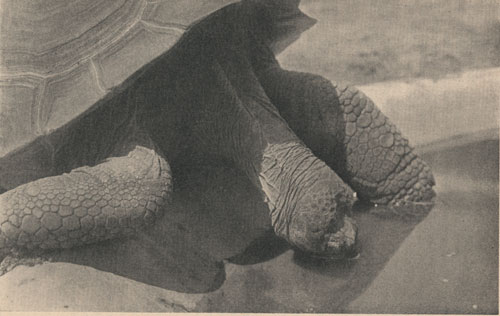
88
|
from a small Ecuadorian vessel that had been sealing at the islands. There were a few vessels from Ecuador that were engaged in sealing and terrapin hunting. The terrapin would be sold for various articles that the whalers might offer in exchange. Captain Smith said that terrapin were seldom fed anything when kept on board Rhaleships. Sometimes, however, they were given a few ioananas. In his trading with the Ecuadorians, he bought also a barrel of terrapin oil, which he took home and distributed among the housewives that he knew at Vineyard Haven. Captain Smith said that the terrapin on Charles Island were exterminated very early, and that Albemarle was the island where whalesmen of his day had the best luck. The terrapin were hard to locate, being usually high in the mountains. The smaller ones were carried on a man's back by a strap arrangement, and the larger ones were carried on a pole, borne by two or more: men. Captain Smith heard of one terrapin that the finders had to abandon. It was estimated to weigh about a thousand pounds, and the men were unable to get it down to the shore. It was found about four miles inland.
Extracts Relative to Galapagos Tortoises from Works on Whaling
The following passages relative to tortoises are from "A narrative of the Sufferings and Adventures of Capt. Charles H. Barnard, in a Voyage Around the World during the years 1812 to 1816:" published in New York in 18?9. The author's first visit to the Galapagos, antedated that of Darwin by nearly twenty years. Captain Barnard, an American, was on board the British whaler Eliza when the latter visited the Galapagos Islands in company with another British whaler. They "came to at Charles's Island," . . . "Boats were dispatched from each ship on the 23d of June (1816) to the shore, to procure terrapin. They were so successful, that at night they returned loaded. . . . After a few days, the Indefatigable13 (a British frigate there at the time) departed for England. The officers and crews of both ships had been actively engaged in procuring a full supply of terrapin." Later, Captain Barnard was on 13 The vessel for which Indefatigable Island was named. |
the ship Millwood (a merchant vessel) of New York, Captain Bailey, which called at Charles Island to procure tortoises: "At 4:00 A.M. of the 28th of October, we accompanied Mr. Cole and ten men, in the pinnace, to the black beach, about three miles distant, to procure terrapin: we arrived there at daylight, and proceeded to the spring, about two miles from the landing. We found a great many terrapin there. They were generally too large for a man to carry, and it was only by culling them that one could be obtained to convey down to the shore. While the men were gone. to the boat, Mr. Cole and myself searched among the surrounding rocks and brambles for more terrapin, and by selecting the smallest, had procured one for each man on his return from the beach. "This spring of fresh water, the only one of living water on the island, is resorted to by the terrapin from the most distant parts of it, instinct being their pilot. They remain round the spring several days, occasionally drinking, until they have filled their five internal reservoirs, when having their twelve months' stock on board, they return to their burrows. While we were here, there was a, continual stir among them. Those that had obtained their stock were marching off, and others arriving to procure theirs. There was one remarkable for his size, as it was supposed he weighed six hundred pounds. Mr. Cole was desirous to get this mammoth on board, but to carry him to the pinnace was considered almost impracticable. I therefore instructed one of the boys how to manage and drive him, and calculated he would be able to reach the landing place by sunset; but he was one quarter of a mile distant from it, when we came up; for his rogue of a driver, when he thought he was not observed, would get on his back, but the terrapin, not being well broken, would not proceed far without stopping. We turned him over, and lashed him to a tree to prevent his getting away, intending to terminate his land travels in the morning. On getting down to the beach, we found we had thirty-four fine terrapin there. On trial we perceived the boat would not carry them all at once; and accordingly five of them were left, four men remaining at the spring. We started for the ship, but the boat was so deep, and rowed so heavily, that we made slow headway, and it was ten o'clock before we got alongside. ... On the 29th we got out the long-boat before daylight, and when it was light, Mr. Cole and six men left for the Black Beach, to procure as many terrapin as they could.... At 6:00 P.M. the long-boat not |
appearing, I went in the pinnace, with a crew, to assist in getting her down, met and took her in tow, and got alongside about eight. Mr. Cole had forty-five terrapin in the boat, including the patriarch. Having now more than seventy on board, Captain Bailey considered that number sufficient." Extracts from "A Narrative of the Life, Travels and Sufferings of Thomas W. Smith," written by himself, and published in Boston in 1844. The following account concerns a part of his experiences on board a British whaling vessel, the ship Spring Grove of London, in the year 1821. "After this we proceeded to Woods' [Hoods] Island, and came to anchor in a suitable harbor. Here we lay three days, during which time we collected 200 terrapins for the cruise and then proceeded to Charles' Island and from thence to Sea. . . . "Having watered our ship [coast of Peru] we sailed for the Gallipagos islands to take in a sufficient number of terrapins to last for the ensuing season on the coast. In two days we arrived at Chatham Island, where we took in 300 large terrapins. . . . "The terrapin resort to the low lands in the rainy season, drinking a sufficient quantity of water, at that time, to serve them during the dry season, which is six months. They then retreat to high ground, in consequence of which the labor of the ship's crew, who go thereto collect them, is great; as they have to pass through a thicket of bushes for a mile or two before they can fall in with any of them. "Individuals have strayed away in these thickets, in search of terrapins, and not being able to find their way out, have perished there for the want of water. My sufferings in this particular, as well as those of some of my ship-mates, were great; and we at times were under the extreme necessity of drinking the blood of the terrapin, and even the water of the animal, with which they like the camel abundantly provide themselves for the season." The following extracts, relative to tortoise hunting on the Galapagos Islands, are from "The Nimrod of the Sea" by William M. Davis, published in New York in 1874. This work is a composite account of the author's whaling experiences. According to Starbuck's History of the American Whale Fishery, Captain Davis was master of the ship Chelsea of New London, on two voyages to the Pacific Ocean-in 1827 and again in 1831. Chapter VIII begins after a landing had been made at black Beach on Charles Island: |
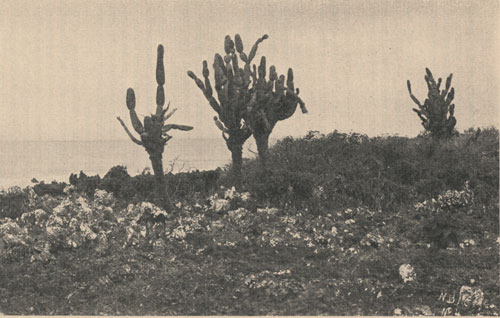
92
|
"We left two men to prepare camp, while the rest started for the back country to hunt terrapin . . . . . Presently to my surprise, I saw our happy darkey 'Zekiel ... sitting on the rear of an enormous terrapin about the size of a wheelbarrow, and much the shape of my mother's forty-gallon apple-butter kettle .... Here was a `baste' that would weigh three hundred pounds at least. In the vicinity were numbers of others of more manageable size, and we selected two of perhaps fifty pounds weight. We tied the fore and hind legs of each so as to leave convenient loops through which to slip our arms, intending thus to carry our capture home, knapsack-fashion, on our backs. . . . I have not a certain idea of the weight these creatures attain, but,think I am within the mark in placing them at four or five hundred pounds. "The true way to carry a terrapin is to form a hand-barrow with deal clubs, or for the largest, of the steering oars, such a contrivance, manned by two or ten men, will bring down the capture with comparative ease." Penetrating into higher country the author continues: "Great numbers of terrapin were about, some of them of immense size-very much larger than any seen on the shore plains here." From Chapter IX: "we took the head off the largest terrapin we could find--one great enough to furnish a feast for a hundred men.--- We were exceedingly thirsty, moreover, and had tried to satisfy our craving with the warm insipid juice obtained from the trunks of the giant cactuses, but in our capture, in our terrapin, we found the living spring of the wilderness. An ample supply of pure limpid water was discovered in the pearly sack placed at the base of the animals neck. There were some three gallons of water here, and, wonder of wonders, it was cool. The temperature of the animal is but 62°, but that of the country may reach 110° in the sun. . . . With one hundred and fifteen terrapin of all sizes secured, we then returned to the ship whose decks were covered with our sleeping captives and the cook's galley steamed with a new and savory odor." From Chapter XIX: "A curious feature of the Galapagos is the novel post-office, established there by Commodore Porter, during the last war with England, while the Essex harbored in the island which bears the name of her worthy captain. He placed a large terrapin shell on a conspicuous point of Black-lava Rock. As round and white as a huge skull, it is a prominent landmark to vessels |
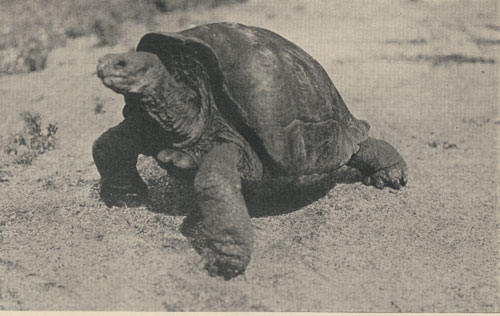
94
|
coasting among the islands. The enormous shell forms the roof of the letter-box, and it is the custom of ships to send a boat ashore and overhaul the mail for any letters that may have been left there for them, and to deposit any letters they may have directed to ships long out which may touch at the islands." In "Eighty Years Ashore and Afloat," by E. C. Cornell, the following extract concerns an incident in the voyage of the ship Apollo. The account is probably true, as there was a ship Apollo of Edgartown, which sailed under Captain Daggett on a whaling voyage to the Pacific in 1816. The captain's name, the vessel's name and the year of sailing check with the book's statements: "After many days reached Claarles Island, where we fell in with two Englishman whalers and a Nantucketer. We came to anchor close by them, and everything being secure went on shore after terrapin. Went far into the interior over to Black Beach, so called from its cinderry appearance. Trees called cabbage wood and prickly pears were scattered here and there; only one spring of water was. found, and that on the extreme south end. We succeeded in taking a good lot of terrapin, usually selecting those most convenient to carry on our backs, the usual way of transporting them. "Here we remained about one week, occupying ourselves daily in the same manner. Frequently it required some time to enable us to find the sized ones best suited to our ideas; they were all the way from as large as a silver dollar to the size of a Henry Clay cook stove. Some were so large that they could easily travel with four good-sized men on their backs. Their chief article of diet when on land is the cabbage-tree leaves, which are broken down by the force of the winds; but sometimes when no high winds lay their food on tl?e ground for them, a large number will congregate, and with one accord gnaw into the bark of these trees, till, coming to the pith which is soft and tender, the tree falls before them. The trees grow to the size of half-barrel. I have often taken them from their work and pointed them in another direction, but if allowed they will return to complete their job, never leaving it until it is completed. Though they appear to enjoy eating as well as other animals, yet they will live and thrive on ship-board for months with nothing on which to subsist. "Three hundred were put on board our ship, stowed between |
decks or anywhere out of the way. They were a strange kind of birds; did not seem to care whether they stood on their head or heels. Their meat was most excellent; usually made it into stifles and soups. They were so fat that half a bucket full of grease could be taken from their upper shell when butchered. The fat was sometimes used to shorten those favorite "duffs" previously alluded to. "The terrapin we had taken were stowed in different parts of the ship, some among the casks between decks, some on deck; it mattered little to us, and apparently less to them, what their accommodations were, so long as they kept out from under foot. With the food they afforded and that of the blackfish constantly on hand, we fared quite sumptously. Our cook used to parboil a sufficient quantity of terrapin over night for next morning's breakfast, when not obliged to be in the boats." There is a detailed account of tortoise hunting on the Galapagos in Captain Thomas Crapo's "Strange but True" published in New Bedford in 1893, pp. 37-38. Captain Crapo visited Albemarle Island in 1858 in the bark Greyhound of Westport, Massachusetts, George G. Cathcart, Master; "On arriving there (Albemarle Island) we dropped anchor. After everything was put in shape, about two-thirds of the crew went ashore, taking with us boat sails to make tents of and water to drink and cook with, as fresh water cannot be found there. After fitting up our temporary camp we started for the mountains after turpin, which are very numerous, and are not found on any other islands. "Turpin are a species of turtle, the shell being in large checks like an alligators skin, and their flesh is unsurpassed as food for soups and stews: its equal cannot be found. The liver is far superior to any kind of meat I ever ate. It is as large as a beef critter's (from a large one), and is many times superior to it in any way you choose to cook it. "In order to get them we had to go high up in the mountains, as that seems to be their roaming ground. They are black in color and move very slow. We did not disturb the large ones, as we would have had to kill and cut them up and carry the pieces down on our backs, as many of them will weigh, I should think, nearly half of a ton. So we caught the smaller ones, none weighing over five or six hundred. "We went hunting them every day for a week, and as they are so |
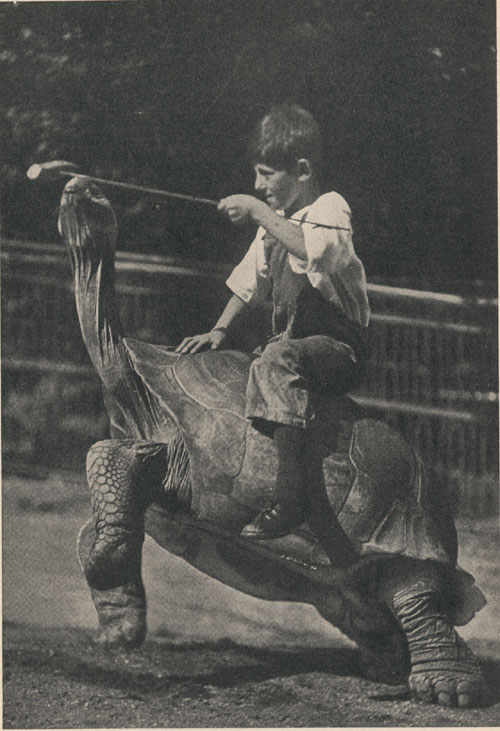
97
|
clumsy and move so slow, made it an easy matter to capture them. We built a pen to put them in, and while on shore lived on them mostly, and used hard bread from the ship for soups and stews and other ways: the cook dished it out to us. The small ones we caught we carried down to camp on our shoulders, but .we had to drag the larger ones. They are perfectly harmless and never known to bite. We caught about a hundred during the time. At the close of the week we took them aboard. Their weights would range from about five pounds to five hundred and over. We put them on deck and between decks, and let them crawl around as they chose. It was all of six months before they were all gone. I never knew one to eat or drink a drop while they were on board, and yet they looked as fat as a ball of butter when they were killed." A record of tortoise hunting at the Galapagos from "Whaling," By Charles Boardman Howes, New York, 1924, p. 117, is as follows: Ship Sukey of Nantucket, John Macy, Master, at Charles Island, June 14, 1812: "I leave this port this Day with 250 Turpin." In "Wanderings and Adventures of Reuben Delano," printed in 1846, the author having sailed on the ship Stanton of Fairhaven, in 1824, tells of a terrapin hunt he engaged in on Indefatigable Island, where 300 terrapin were taken. There is a brief reference to Galapagos tortoises in William Mariner's "Tonga," published in Edinburg in 1827, which appears to have been overlooked by writers on this subject. Mariner accompanied the ship Port au Prince, whaler and privateer, on a voyage to the Pacific in 1805. The record is as follows: "On Wednesday the 16th (October) made Chatham Island, one of the Galapagos. Whilst at this place, some turpin (landtortoise) was procured from on shore." There are some references to the tortoises of the Galapagos Islands in the journal of David G. Farragut,14 a young officer attached to the U.S.S. Essex in 1813: "At Charles Island we let some of the men go on shore daily to take a run. They amused themselves by appointing one as a cook while the rest went in search of tortoises and water." Among the captures made by the Essex were the British whaleships Atlantic and Greenwich: "From these two vessels we secured water and tortoises euough to supply us for some time. On the 14 Life of Farragut, by his son Loyall Farragut, New York, 1879. |
6th of June we saw a beautiful sight, a volcano in a state of eruption on the Island of Narboro." Writing of the capture of the British whaleships Georgiana and Policy, he says (p. 23): "In clearing their decks for action, they had thrown overboard several hundred Galapagos terrapins. The appearance of these turtles in the water was very singular: they floated as light as corks, stretching their long necks as high as possible . many were picked up, which afforded us an abundant supply of fresh provisions for officers and crew. The meat, cooked in almost any manner, is delicious."
The Preservation of the Galapagos Tortoises
The Executive Committee of the New York Zoological Society has signified its intention to procure if possible living specimens of Galapagos tortoises in the hope of averting the impending extinction of these animals. The edible value of the tortoises is sufficient reason for an attempt to locate a number in some southern locality where suitable climatic and food conditions would favor their increase. Their survival in the Galapagos where natives and wild dogs are equally destructive, seems to be quite hopeless. The last important collection of Galapagos tortoises was that made in 1905 under the direction of Mr. R. H. Beck for the California Academy of Sciences, when about 250 individuals were secured and preserved as museum specimens. More than one hundred of these were found in the high interior of Albemarle Island, where it is possible that survivors persist. This expedition spent nearly a year at the islands. The taking of such a number for scientific purposes appears to be justified in view of the heavy slaughter by Ecuadorian oil makers that had long been in progress on Albemarle, and was likely to be continued as long as there were profitable returns. While Galapagos tortoises have lived for many years in the New York Zoological Park, in the National Zoological Park at Washington, in England and elsewhere, they do not breed in northern climates. A fact to be noted in connection with their failure to reproduce is that the tortoises now living in captivity are nearly all males. Being hardy animals and easily cared for, a number of them |
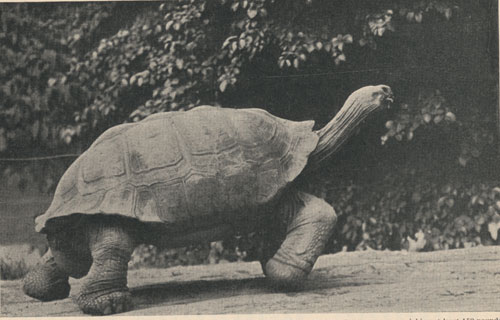
100
|
should be transported to a carefully selected breeding base, where their protection would be assured. The present writer visited the Galapagos Islands in 1888 in the U. S. Fisheries Steamer Albatross, when eighteen tortoises were obtained from Duncan and Chatham islands; those from the latter having been taken there from Indefatigable Island. He revisited the Galapagos in the Albatross in 1891, when a single tortoise was obtained at Duncan Island, no search for tortoises being made on other islands. All of these reached Washington alive and in good condition but as a result of improper care did not survive the following winter. On board the Albatross they had the freedom of the deck and fed freely on such fruits and vegetables as were available. It is now known that they grow faster than was formerly supposed. According to Messrs. Daggett and Heller a twenty-nine pound specimen taken to California in 1899 doubled its weight annually and in sixteen years attained a weight of 450 pounds. They are also long lived. There are authentic records of individuals that lived more than a century in captivity. It is known that the females lay numerous eggs. The species of giant tortoise (Testudo elephantina) formerly abundant on Aldabra and other islands in the Indian Ocean, but later brought to the verge of extermination, is now increasing under Government protection. In 1906 Mr. M. J. Nicoll visited the Seychelles15 in the Indian Ocean, and described the giant tortoises now living there: "In the grounds of Government House we saw a large number of Aldabra tortoises. Some of them were of large size and a great many were newly hatched. We were informed that they bred freely in confinement and that the young grew very quickly. These tortoises are used for food by the natives and on visiting the market we saw several tethered by the leg and exposed for sale. On all the islands and inhabited islets of this group, there were tortoise farms. In nearly all these farms the tortoises bear a number which is painted in white on the shell. Many farm-owners keep a record of all their stock, while at Government House a complete register is made with the daces of hatching and so forth. At the latter place we rode upon the largest tortoise. 15 Three Voyages of a Naturalist. Scribners, New York, 1908. |
![A Galapagos tortoise (Testudo vicina) in action. This is the same specimen as shown on page 97 [Fig. 30]. From the New York Zoological Park.](cht102.jpg)
102
|
All these tortoises have been imported from Aldabra and there are now probably considerably more individuals on the Seychelles than on the former island." Aldabra and the Seychelles lie north of Madagascar. There can be no doubt that the giant tortoises of the Galapagos are as well adapted to semi-domestication as the great tortoise of Aldabra. Having developed great size and high edible qualities on desert islands, the Galapagos tortoises might prove of great value among our food resources, especially in arid regions. With a steadily increasing population, the world's food production must soon be increased. Three centuries of navigators feasted abundantly on the tortoises of the Galapagos. No other large land reptile ever figured so importantly in the food supply of mankind. The tortoise islands of the Indian Ocean, also visited by food seeking ships, could not apparently, have borne such numbers as the much larger islands of the Galapagos. According to the late Doctor Van Denburg who reported upon the numerous tortoises collected for the California Academy of Sciences in 1905-1906, the state of our knowledge respecting the numbers of tortoises remaining on the Galapagos Islands is as follows:
It is altogether improbable that the conditions of nearly twenty years ago obtain at the present time. The tortoises of the smaller 16 The Gigantic Land Tortoises of the Galapagos Archipelago. By John Van Denburg, Proc. Cal. Acad. Sci., 1914. | |||||||||||||||||||||||||||||||||||||||||||||||||||||||||||||||||||||||||||||||||||
islands have doubtless suffered further depletion in numbers. Survivors if sought for are most likely to be found in the large islands of Albemarle and Indefatigable, the interior regions of which are exceptionally difficult to penetrate. A remarkable fact in connection with the giant tortoises is their amazing abundance at the time of the discovery of the islands. This continued for more than two centuries or until the first settlement in 1832, despite the inroads made upon them by food-seeking ships. All of the early navigators make mention of their abundance. Dampier who visited the Galapagos in 1684 says "It is incredible to report how numerous they are." What a contribution could be made to the world's food supply if the otherwise unimportant islands where, unknown to primitive man, the tortoises reached such an amazing development, could be cleared of the pests introduced by civilized man and the original conditions restored! This is now unfortunately impossible on the Galapagos. The only remaining hope for the race is the establishment of survivors elsewhere.
APPENDIX
Logbook Records of Tortoises Taken from the Galapagos Islands by Certain Whaleships from 1831 to 1868 17
17 Extracts from the logs are quoted verbatim. |
|
1833. Ship Hector (cont.)
|
1834. Ship Moss (cont.)
|
1835. Ship Barclay (cont.)
|
1835. Ship Lima (cont.)
* * * * *
|
|
1837. Ship Eliza Adams (cont.)
|
1838. Ship George and Susan (cont.)
|
1840. Ship Robert Edwards (cont.)
|
1841. Ship Chili (cont.)
|
|
|
1844. Bark Equator (cont.)
|
1845. Bark Equator (cont.)
|
1846. Bark Equator (cont.)
|
|
|
1848. Ship Congaree (cont.)
|
|
1850. Ship Martha (cont.)
|
1853. Ship Congaree (cont.)
* * * * *
|
1854. Bark Superior (cont.)
|
1855. Ship Mary Ann (cont.)
|
1859. Bark Montgomery (cont.)
|
1860. Bark Atkins Adams (cont.)
|
1861. Bark Morning Star (cont.)
|
1862. Ship Edward Carey (cont.)
|
1868. Ship Roscoe (cont.)
Record of Vessels Seeking or Obtaining Tortoises, but Numbers Taken not Recorded
|
1836. Bark Pioneer (cont.)
|
|
|
NOTES.Contents and illustrations pages have been added to facilitate navigation. |
TOWNSEND, CHARLES HASKINS,
|
SOURCE.Townsend, Charles Haskins, 1859-1944
This monograph may be found at the Biodiversity Heritage Library.
Last updated by Tom Tyler, Denver, CO, USA, December 28, 2024.
|
|